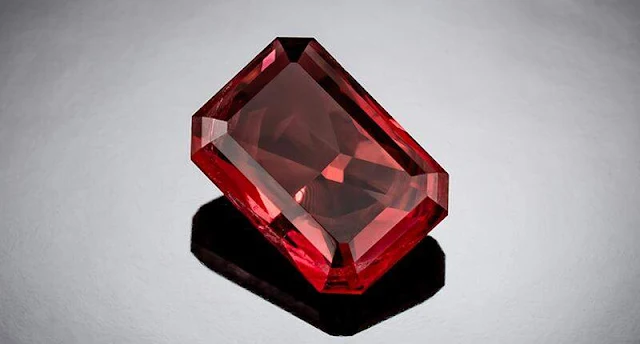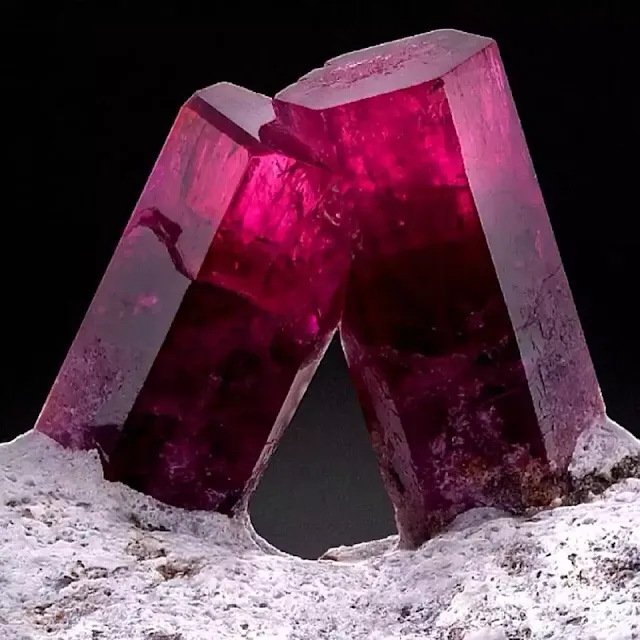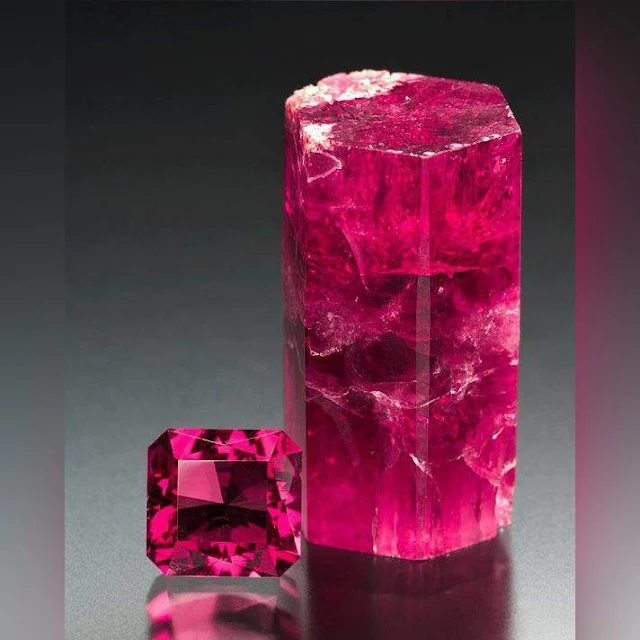Red Beryl: Bixbite
Red beryl (Bixbite) is a stunning and incredibly rare variety of the beryl mineral. It's known for its vibrant red color, ranging from cherry red to raspberry pink, and its exceptional rarity, making it one of the most valuable gemstones on Earth.
Red beryl is one of the rarest and most valuable gemstones on Earth. It's a variety of the beryl family, which includes more common gems like emerald and aquamarine. But unlike its green and blue cousins, red beryl is incredibly scarce.
Red beryl, also known as bixbite, is a precious gemstone belonging to the beryl family. It's renowned for its vibrant red color, ranging from pinkish red to deep, saturated hues. This color comes from trace amounts of manganese replacing aluminum atoms within the crystal structure.
The name "bixbite" comes from Maynard Bixby, the discoverer of the first red beryl crystals in Utah in 1920.
 |
| Red Beryl crystals from Wah Wah Mountains Utah |
How is Red Beryl Formed
Red beryl typically occurs in association with topaz-bearing rhyolites, which are volcanic rocks rich in silicon, aluminum, and fluorine. These rocks form when magma cools and crystallizes near the Earth's surface. Hot, mineral-rich fluids (hydrothermal fluids) circulate through fractures and cavities within the rhyolite. These fluids are believed to originate from a deeper magma chamber or from surface water interacting with the hot rock.
The hydrothermal fluids carry dissolved elements like beryllium, manganese, aluminum, and silicon. Under specific conditions of low pressure and high temperature within the rhyolite, these elements combine and crystallize as red beryl, typically in cavities or along fractures.
The distinctive red color of bixbite arises from the presence of manganese ions incorporated into the crystal structure. These ions replace some of the aluminum ions within the beryl lattice, causing the characteristic red hue.
The formation of gem-quality red beryl requires specific factors like slow crystal growth, minimal internal flaws, and adequate crystal size. These conditions are rarely met, contributing to the rarity and high value of this gemstone.
 |
| Red Beryl gemstone |
Red Beryl Properties
Composition: Be₃Al₂Si₆O₁₈ with some Al replaced by Mn³⁺ (manganese). This substitution gives rise to the red color.
Color: Deep red, ranging from strawberry and cherry red to orange-red and purplish-red. Intensity and hue can vary slightly depending on the specific manganese content and distribution.
Luster: Vitreous: Glassy, with a bright and reflective shine.
Crystal System: Hexagonal: Crystals exhibit six-fold symmetry along their main axis.
Streak: White: When scratched on a rough surface, red beryl leaves a white powder mark.
Hardness: 7.5-8 on the Mohs scale: hard, can scratch most other minerals except for harder ones like topaz and corundum.
Cleavage: Imperfect basal: Tendency to break along a specific plane parallel to the crystal base, but not as pronounced as in some other minerals.
Crystal Form: Prismatic: Elongated crystals with rectangular or hexagonal cross-sections, often terminated by flat pinacoid faces.
Density: 2.80-2.89 g/cm³: Relatively heavy for its size compared to other gemstones.
Transparency: Translucent to transparent: Can range from allowing some light to pass through (translucent) to completely clear (transparent).
Specific Gravity: 3.44-3.50: A ratio of the mineral's density to the density of water. Higher than water, indicating its heaviness.
Solubility: Insoluble in most acids: Resistant to chemical breakdown by common acids.
Fluorescence: Weak orange-red under longwave UV: Emits a faint orange-red glow when exposed to long-wavelength ultraviolet light.
Pleochroism: Distinct, red to orange-red: Shows different shades of red depending on the viewing direction, adding depth and complexity to the color.
Refractive Index: 1.565-1.577: A measure of how much light bends when passing through the mineral. Influences its brilliance and sparkle.
Inclusions: Inclusions are very common in red beryl. Some common types of inclusions include:
- Mineral inclusions: These can include other minerals like mica, feldspar, or quartz.
- Fractures: These are cracks or breaks in the crystal structure.
- Needle-like inclusions: These are tiny, hair-like inclusions that can affect the clarity of the stone.
However, these inclusions can vary significantly in their presence and impact on the gem's value. Flawless or nearly flawless red beryl crystals are exceptionally rare and highly valuable.
 |
| Red Beryl - from Wah Wah Mts, Beaver County, Utah, USA Photo: Barras-Gautier Minéraux |
Where is Red Beryl Found
The only known commercial occurrence of gem-quality red beryl is in the Ruby-Violet Mine, located in the Wah Wah Mountains of Utah, USA. This mine is within a topaz rhyolite formation that experienced the specific geological and hydrothermal conditions necessary for bixbite formation.
Why is Red Beryl So Rare
Red beryl's rarity stems from a confluence of factors, not just one singular reason.
Geologic Rarity: The specific geochemical and hydrothermal conditions necessary for red beryl formation are incredibly rare. Only a handful of locations worldwide have these conditions, and many lack gem-quality potential.
Uncommon Host Rock: Red beryl typically forms within topaz-bearing rhyolites, which are themselves relatively uncommon volcanic rocks. This further limits the potential search areas.
Small Crystal Size: Red beryl crystals rarely exceed a few centimeters in length, making facetable gems even more scarce. The largest faceted red beryl known is only around 8 carats.
Due to its rarity and environmental concerns, red beryl mining is often restricted or discouraged. This further limits the supply available to the market.
Collector's Item: Despite its limited availability, red beryl remains highly sought-after by collectors and investors due to its beauty and rarity, perpetuating its high value.
 |
| Beryl twin from Wah Wah Mts, Beaver County, Utah. Photo By Benjamin DeCamp |
How Rare is Red Beryl Compared to Other Gemstones
Diamonds vs. Red Beryl: One red
beryl crystal is found for every 150,000 diamonds. Considering the
abundance of diamonds, this ratio showcases the extreme scarcity of red
beryl.
100 times rarer than emerald: Red beryl is over 100 times rarer than emerald, the most common and well-known beryl variety.
Rubies: While rubies also come in vibrant red hues, they're substantially more common than red beryl. You'd find numerous ruby deposits around the world compared to the limited locations where red beryl forms.
Benitoite: Another rare gem, benitoite, holds the title of "California's official state gemstone." Despite this distinction, red beryl still outshines it in terms of rarity.
 |
| Cut and Rough Red Beryl |
Red Beryl Price
Price range:
Rough stones: Lower-quality rough red beryl can start around $500 per carat, while high-quality rough with potential for gem-quality cuts can reach $10,000-$20,000 per carat.
Faceted stones: Prices for faceted red beryl vary greatly based on the factors mentioned above. Smaller, less vibrant stones might start around $800 per carat, while larger, high-quality stones with intense color can reach $25,000-$50,000 per carat or even higher. Exceptional stones exceeding 5 carats can fetch astronomical prices, reaching six figures or even millions.
Factors influencing price:
- Color: The intensity and purity of the red hue play a crucial role. Vibrant, saturated colors are more valuable than paler shades or those with brown or orange tones.
- Clarity: The presence of inclusions or fractures can significantly decrease the value. Flawless stones are extremely rare and command the highest prices.
- Size: Larger stones are rarer and therefore more expensive. However, cutting a larger stone into smaller, flawless gems can also be valuable.
- Cut: The quality of the cut affects the stone's brilliance and fire, impacting its value.
Conclusion
In conclusion, red beryl's rarity extends beyond being simply "rare." It occupies a unique position on the spectrum of scarcity due to its limited geological formation, single source location, restricted crystal size, and stringent gem-quality criteria. These combined factors solidify its status as one of the most precious and sought-after minerals on Earth.
Read also:
Beryl: The Different Beryl Varieties








